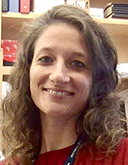 |
Sarah Bizzotto, PhD
Mentor: Christopher Walsh, MD, PhD
Project Title: Exploring new genetic causes and pathological mechanisms of epileptic focal cortical dysplasia
Dr. Bizzotto has been working on lineage tracing studies that aim to elucidate normal human brain development, as well as on projects that focus on the mechanisms of epileptic focal malformations (FCDs). These are debilitating orphan diseases that account for the majority of pharmaco-resistant epilepsies in the pediatric population requiring surgical treatment. Recent studies have established that FCDs are caused most commonly by somatic mosaic mutations that result in gain of function of the mTOR pathway and brain tissue overgrowth. Despite these advances, most cases still remain genetically unsolved. Dr. Bizzotto plans to perform ultra-deep sequencing on a wide list of candidate genes never screened before in such diseases. She also plans to apply single cell techniques that will allow to identify cell types carrying pathogenic mutations. In this way, she hopes to clarify novel genetic causes and developmental mechanisms of FCD, which will hopefully contribute to the ideation of optimal treatment strategies for these debilitating conditions.
|
 |
Mehdi Pirouz, PhD
Mentor: Richard Gregory, PhD
Project Title: ole of Dis3l2 Exoribonuclease in the Pediatric Perlman Syndrome
Perlman syndrome is a rare but devastating pediatric disorder caused by a deficiency in an enzyme (an exonuclease) that degrades certain RNAs. Patients with mutations in the DIS3L2 gene often die within the first few days-months of life and have a variety of severe symptoms including kidney abnormalities, altered glucose levels in the blood, developmental defects including fetal overgrowth, characteristic facial features, neurodevelopmental problems, and are prone to develop Wilms tumors in the kidney. We were among the first to identify that the normal function of Dis3l2 is the quality control of a subset of regulatory RNAs. How deficiency in DIS3L2 leads causes Perlman syndrome remains unknown and is the focus of this research project. We have deleted the Dis3l2 gene in mice to generate a model of Perlman syndrome and will use a toolbox of molecular approaches that we have recently developed to understand the molecular and physiological connections between defective RNA surveillance caused by Dis3l2 deficiency and pediatric Perlman syndrome. I aim to establish whether Perlman syndrome is caused by the accumulation of defective RNAs that leads to the altered translation and production of a subset of proteins. We will test whether this leads to the phenotypes that are commonly observed in the Perlman syndrome patients and our preliminary data indicate are recapitulated in the new mouse model. Successful completion of this project has broad implications in understanding the basis of this disease and provides opportunities for future therapies.
|
 |
Zhingjie Fu, PhD
Mentor: Louis Smith, MD, PhD
Project Title: FGF21 protects against retinal degeneration in retinitis pigmentosa
Dr. Fu continues her research interest in investigating the role of nutrient supply and metabolism in eye diseases. Her work has addressed the contribution of glucose metabolic disturbance to the neuronal changes and the inhibition of normal vessel growth as well as promotion of pathologic vessel growth in various retinal diseases. Dr. Fu has found that abnormal glucose metabolism caused photoreceptor dysfunction, retinal oxidative stress, inflammation, as well as glial responses, resulting in damaged retinal neurons and disturbed retinal vasculature. She has demonstrated that targeting retinal glucose metabolism by hormonal modulation may be important in the treatment of retinal metabolic disorders. Now Dr. Fu is on her way to initiating independent research projects as an instructor, and she aims to explore the effects of fibroblast growth factor 21 (FGF21, a key metabolic modulator) on photoreceptor survival during retinal degeneration. To achieve this goal, she will investigate the metabolic alterations in the widely-used retinitis pigmentosa model P23H mutant mice and examine if FGF21 administration restores photoreceptor energy production and function. Retinitis pigmentosa is a rare disease with various genetic causes and affects about 1 in 4000 people in the U.S. It is typically diagnosed in adolescence. Most people with retinitis pigmentosa are legally blind by age 40 and there are long-term impacts on the quality of life in patients. Unfortunately, there is no effective treatment so far. Therefore, there is a high demand to identify safe and effective treatments to rescue photoreceptor function. With the help of this grant, Dr. Fu will contribute to this effort and hope to find a generalized treatment in retinitis pigmentosa with various genetic causes.
|
 |
Neha Nagpal, PhD
Mentor: Suneet Agarwal, MD, PhD
Project Title: Mechanisms and therapeutic targeting of non-coding RNA dysregulation in telomere diseases
Dr. Nagpal has been developing small molecule strategies to modulate human telomerase. Specifically, she discovered novel small molecules that have the potential to restore telomere maintenance in patients with dyskeratosis congenita (DC). DC is one of a spectrum of rare genetic diseases caused by mutations in genes regulating telomere biology. Despite major advances in this area, there are yet no targeted or systemic therapies available for patients with telomere diseases. Dr. Nagpal proposes to study the post-transcriptional regulation of non-coding RNAs including the telomerase RNA component (TERC). Her work will address molecular pathophysiology across a range of DC genotypes and explore the possibility of manipulating dysregulated non-coding RNAs using novel small molecules. These studies have the potential to provide novel therapies to address the growing class of telomere diseases and associated rare, degenerative disorders.
|